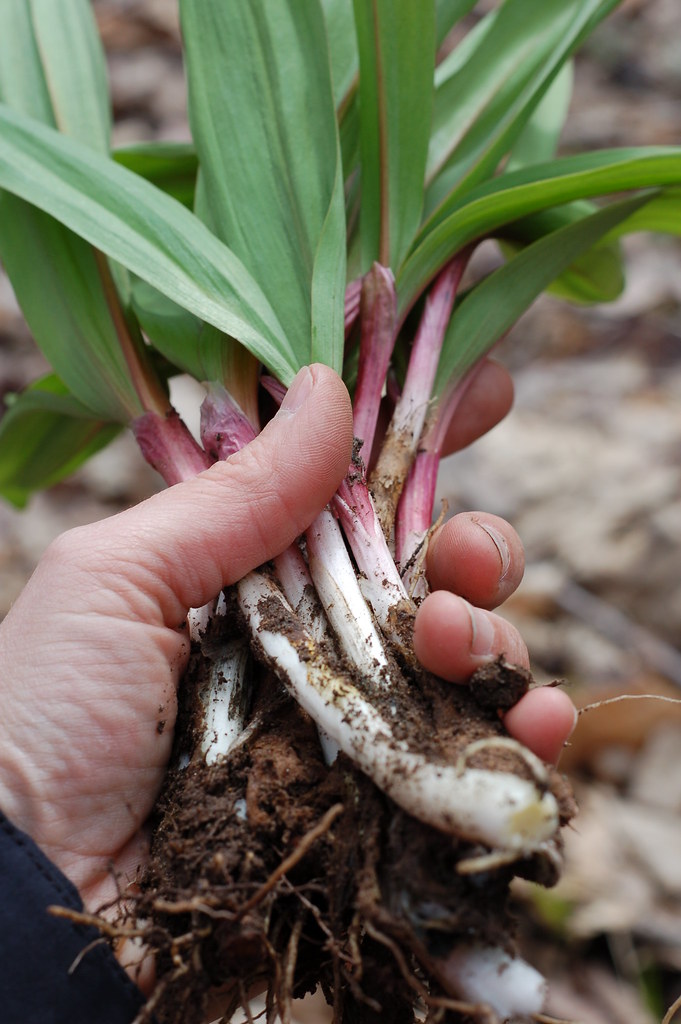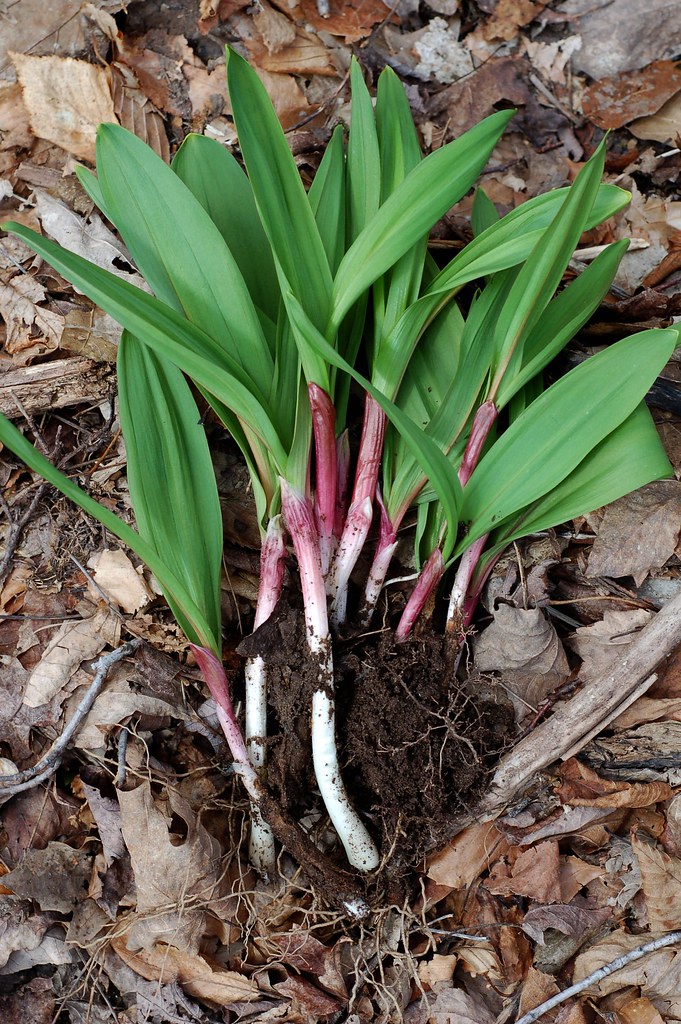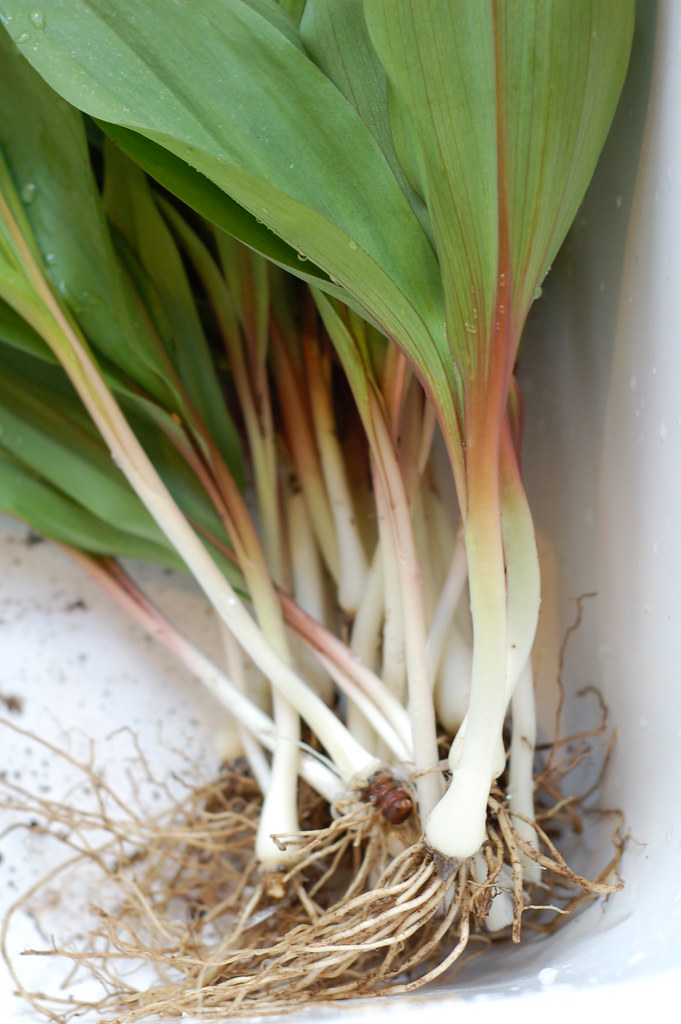As I mentioned in my post about harvesting these beautiful ramps, I planned to make a few tasty things with my haul. Risotto was at the very top of that list but, sadly, I did not have any Arborio rice in the house the day I harvested the ramps - quel dommage!
I had to settle for making my second choice - wild ramp and parsley pesto (which was delicious) and writing "ARBORIO RICE!!!" on the grocery list.
I am a big fan of risotto - it's creamy, comforting and hearty, as well as a perfect palette for flavors both subtle and bold. And I just KNEW the combination of the garlicky ramps, fresh, floral lemon and creamy risotto would be delicious.
I began by separating the ramp stalks from the leaves so that I'd be able to cook each part for the best flavor and consistency.
You don't add the chopped up greens until the very end of cooking, then you fold them into the risotto, along with the lemon zest and Parmesan cheese.
Just a little lemon zest adds a world of light flavor to this dish. And thanks to my beloved microplane zester, it only takes a few seconds to produce a lovely little pile of zest.
The first step of the cooking process is to sautée the chopped ramp stalks and shallot in butter.
Once the ramp stalks and shallot have softened, you add the Arborio rice and sautée it for a few minutes, stirring all the while, until the edges of each grain of rice edges become opaque and the center turns white.
Then comes the tedious part - add stock and stir repeatedly until it's absorbed. Repeat. Repeat. Repeat. Repeat. Repeat. Repeat. Repeat...
Just when you begin to fear that your arm may actually drop off from all the stirring, it's time to fold in the ramp greens, lemon zest and grated Parmesan cheese! Stir well to ensure even distribution of these yummy late-stage additions.
Now it's time to rest your stirring arm and enjoy the fruits of your labor.
-- print recipe --Wild Ramp & Lemon Risotto
Serves 4-6
Ingredients
* 1 large bunch of wild ramps (8-10), cleaned and trimmed with the roots removed (instructions here)
* 2 large shallots
* 2 Tbsp olive oil or butter
* 7 cups organic chicken or vegetable stock
* 2 cups Arborio rice (risotto)
* 1/2 cup dry white wine
* 1 cup freshly grated Parmesan cheese
* 1 Tbsp lemon zest (use an organic lemon - you don't want any yucky pesticides or wax)
* Sea salt
* Freshly ground black pepper
Directions
1. Separate the ramp stalks from the greens and chop each, keeping them separate. Finely chop the shallots.
2. Heat the stock in a saucepan (you'll want to position this right behind whatever burner you plan to use for the risotto pan since you're going to be ladling stock into the pan continuously during the cooking process.) Cover the stock and leave it on low at a simmer (it will need to stay hot the entire time you're cooking the risotto.)
3. In a large, heavy bottomed pan (there are special risotto pans but although nice, they're not necessary) melt the butter and cook the onion on medium-low heat until softened, about 5 minutes.
4. Add the rice and stir to coat all the grains with butter. Sautée the rice for 2-3 minutes until the rice becomes chalky and you can see a white dot in the center of each grain. Then add the wine and cook for 2 minutes, stirring, until it's been absorbed.
5. Now the fun begins (by the end of this, your arm will be very tired!) Add one cup of the hot stock to the pan and stir until it has all been absorbed by the rice - if you don't stir and cook until the liquid is absorbed with each addition, the rice will get very gummy).
6. Continue to add stock, one cup at a time, stirring constantly until the rice has absorbed the liquid and starts to seem dry before adding more stock. Once you've added 6 cups of the stock, you should start adding 1/2 cup at a time. Keep doing this until the rice is cooked through but still a little al dente, about 30 minutes total (you may not end up using all of the stock but it should be pretty close -- if you run out of stock, you can substitute hot water towards the end.)
8. Turn off the heat, add the chopped ramp greens, lemon zest, and Parmesan cheese, mix well to incorporate, then season with salt (if needed) and freshly ground black pepper, and serve.
Serves 4-6
Ingredients
* 1 large bunch of wild ramps (8-10), cleaned and trimmed with the roots removed (instructions here)
* 2 large shallots
* 2 Tbsp olive oil or butter
* 7 cups organic chicken or vegetable stock
* 2 cups Arborio rice (risotto)
* 1/2 cup dry white wine
* 1 cup freshly grated Parmesan cheese
* 1 Tbsp lemon zest (use an organic lemon - you don't want any yucky pesticides or wax)
* Sea salt
* Freshly ground black pepper
Directions
1. Separate the ramp stalks from the greens and chop each, keeping them separate. Finely chop the shallots.
2. Heat the stock in a saucepan (you'll want to position this right behind whatever burner you plan to use for the risotto pan since you're going to be ladling stock into the pan continuously during the cooking process.) Cover the stock and leave it on low at a simmer (it will need to stay hot the entire time you're cooking the risotto.)
3. In a large, heavy bottomed pan (there are special risotto pans but although nice, they're not necessary) melt the butter and cook the onion on medium-low heat until softened, about 5 minutes.
4. Add the rice and stir to coat all the grains with butter. Sautée the rice for 2-3 minutes until the rice becomes chalky and you can see a white dot in the center of each grain. Then add the wine and cook for 2 minutes, stirring, until it's been absorbed.
5. Now the fun begins (by the end of this, your arm will be very tired!) Add one cup of the hot stock to the pan and stir until it has all been absorbed by the rice - if you don't stir and cook until the liquid is absorbed with each addition, the rice will get very gummy).
6. Continue to add stock, one cup at a time, stirring constantly until the rice has absorbed the liquid and starts to seem dry before adding more stock. Once you've added 6 cups of the stock, you should start adding 1/2 cup at a time. Keep doing this until the rice is cooked through but still a little al dente, about 30 minutes total (you may not end up using all of the stock but it should be pretty close -- if you run out of stock, you can substitute hot water towards the end.)
8. Turn off the heat, add the chopped ramp greens, lemon zest, and Parmesan cheese, mix well to incorporate, then season with salt (if needed) and freshly ground black pepper, and serve.
You might also like:







